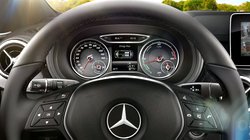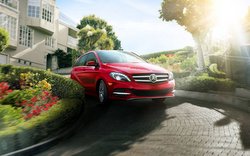A Touch of Luxury Class in EVs
There’s an electric-powered Mercedes-Benz out there, but you can be forgiven if you haven’t noticed. Quietly, the 2016 Mercedes-Benz B250e is rolling around town, if you happen to be in

California or other EV friendly locales.
The B250e is a five-door hatchback–not the shape you expect from Mercedes. The B-Class is sold in other parts of the world, including Canada, as a small, utility-minded gasoline-, diesel- or natural gas-powered car. However, in the U.S., B-Class cars are EVs only (labeled Electric Drive). Some of the last generation B-Class cars were also leased in California as fuel cell electrics.
It makes sense for the German giant to put an all-electric powertrain in a small vehicle. Roughly the size of a Nissan Leaf, it has less weight to labor the battery pack. With a folding rear seat, it’s spacious in the back. In the bright blue of my colleague Pam’s new commuter car, it has a friendly aspect to it.
An Opportunity at the Charger
I’ve been eager to test Mercedes’ baby EV, so when I saw one attached to the chargers at my building, I slipped my card under the driver’s side wiper and waited for the owner to respond. Pam did, and offered to show me around the car–and even let me drive it for a few miles.

The B250e may look like a generic hatchback (despite its dramatic character line that rises up the side), but inside, it feels like a Mercedes-Benz. While not furnished in rare woods, and rich leather, it has dignity and mass—and an instrument panel that looks like a Mercedes-Benz should. It feels more upscale than other EVs I’ve tested. It can’t match a Tesla, of course, but it’s not priced as one, either.
Driving the car, judging from my brief test, is pleasant and, of course, silent. There are settings for S (sport), E (eco) and E+ (eco plus), and, I think, a “normal” setting. If you set it to S, you get the full benefit of an electric motor’s instant torque and rocket ahead with a snap. In E or especially E+, the drivetrain feels anaesthetized, but that’s so you use less juice.
The Stats
Stats for the 2016 Mercedes-Benz B250e are: 132 kW electric motor with 177 horsepower, 251 lb.-ft. of torque, capable of 0-60 in 7.9 seconds. Pam, who stepped out of a reliable Mercedes-Benz M-

Class SUV, has been getting about 83 miles per charge in her new B, which puts it in the realm of the original Leaf and other cars like the Ford Focus EV and Fiat 500e. Mercedes claims 87 miles. But the future is looming, with 200+ mile range EVs on their way, so I’m guessing that the Tesla-sourced engine/battery will be getting an upgrade before too long. Meanwhile, for a commute from southern San Jose to San Mateo, California, the little Mercedes-Benz EV is just the ticket. Pam has Level 2 (240-volt) charging at home and here at work, so she never has to run out of juice, as long as she doesn’t stray too far from the normal path.
Pricing is officially $41,450 (for 2016 models; 2017s list at $39,900), but as you might expect, leasing drops costs considerably. Pam leased hers for a little bit more than $300 a month with some money down. The federal rebate was applied directly to the lease, and her California state rebate is on its way. She relishes her white carpool-lane stickers, too.
A Luxury EV–Not a Lot of Competition

The 2016 Mercedes-Benz B250e is a natural competitor to the BMW i3, and, as these two German competitors go, it’s the more sober, elegant one, versus the radical BMW. But by all means, you should cross-shop.
I’m eagerly awaiting my chance to spend a week with this car, but for now, it looks like a winner to me–for the right driver and purpose.
Related Stories You Might Enjoy:
Road Test: 2016 Nissan Leaf
Road Test: 2016 Ford Focus Electric
Road Test: 2016 Fiat 500e
Road Test: 2016 Kia Soul EV
Road Test: 2014 BMW i3

4 thoughts on “First Drive: 2016 Mercedes-Benz B250e”